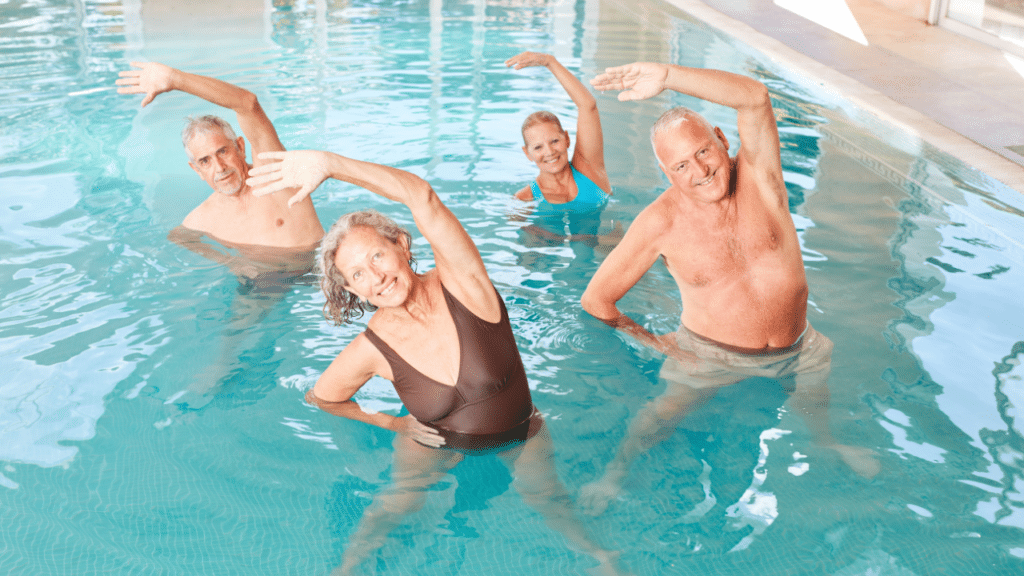|
Getting your Trinity Audio player ready...
|
Takeaways
- Discover how exercise can positively impact Alzheimer’s and dementia symptoms.
- Engaging in regular exercise can enhance memory, reduce dementia risk, and promote overall brain function.
- Contrast Oxygen Therapy (COT) offers a unique method to nurture brain resilience, improving Alzheimer’s Disease’s symptoms.
Table of Contents
- Aerobic Exercise: Supercharge Your Brain with Cardio Workouts
- Strength Training: Transform Your Brain with Muscle-Building Fun
- Dual Task Exercises: Synergizing Mind and Body for Cognitive Fitness
- Contrast Oxygen Therapy: Nurturing Brain Health with Controlled Stress
Imagine a world where the progression of Alzheimer’s and dementia could be slowed and even improved. It sounds almost too good to be true, right? Well, the surprising truth is that exercise plays a crucial role in making this transformation a reality.
Get ready to embark on a journey that dives into the remarkable impact of four distinct exercise types on brain health. Dr. Heather Sandison, ND, the visionary behind Solcere Health Clinic and Marama, will guide us through this enlightening exploration.
1. Aerobic Exercise: Supercharge Your Brain with Cardio Workouts

Did you know that your brain thrives on blood flow? That’s right – maintaining good brain function is directly linked to a well-functioning cardiovascular system. The Framingham Heart Study, The American Heart Association, The National Institute on Aging, and The Alzheimer’s Association have all funded studies that demonstrate this.
Engaging in aerobic exercise can significantly boost blood flow to the brain! Activities like brisk walking, swimming, biking, and even tennis can elevate your heart rate and ensure a steady flow of nutrients and oxygen to your brain.
The Framingham Heart Study, a monumental research effort that has been tracking the health of thousands of people in Framingham, Massachusetts, since 1948, underpins the importance of sustained aerobic exercise in supporting brain health.
Findings from this study has found that people who are physically active and have a healthy cardiovascular system are less likely to develop dementia, including Alzheimer’s disease.
Aerobic exercise helps to improve blood flow to the brain, which can help to protect neurons from damage. It also helps to increase the production of brain-derived neurotrophic factor (BDNF), a protein that promotes the growth and survival of neurons.
One study has also found that the benefits of aerobic exercise for brain health are cumulative. The more you exercise, the greater the benefits! Even a moderate amount of exercise, such as 30 minutes of brisk walking most days of the week, can make a difference.
One report discusses specific ways that aerobic exercise can help to support brain health:
- Improve blood flow to the brain: Aerobic exercise helps to increase the production of nitric oxide, a gas that relaxes blood vessels and improves blood flow.
- Increase the production of BDNF: BDNF is a protein that promotes the growth and survival of neurons.
- Reduce inflammation: Inflammation is a major risk factor for Alzheimer’s disease and other forms of dementia.
- Improve mood: Depression and anxiety are both risk factors for dementia.
If you are looking for ways to improve your brain health, aerobic exercise is a great place to start. Even a moderate amount of exercise can make a difference. So get moving and start enjoying the benefits of physical activity for your brain!
2. Strength Training: Transform Your Brain with Muscle-Building Fun

Building muscles isn’t just for looking like a superhero; it’s a potent tool for brain health. As we age, muscle wasting, also called sarcopenia, becomes a concern . You can combat this by doing strength training exercises.
Doing this can help you:
- Improve your memory and cognitive function.
- Reduce your risk of dementia.
- Improve your mood and reduce stress.
- Increase your energy levels.
- Lose weight or maintain a healthy weight.
- Build muscle.
- Reduce your risk of injuries.
- Boost your self-confidence and sense of well-being.
Engaging with a professional trainer can also aid in building muscle mass. Strength training can boost these hormones to help your brain grow and thrive!
3. Dual Task Exercises: Synergizing Mind and Body for Cognitive Fitness

Science has taken notice, and the results are in: dual-task exercises are like a secret code to unlock cognitive fitness. These exercises demand that your brain multitasks – processing puzzles, remembering President’s names, or solving challenges – all while your body is on the move.
Imagine combining learning with physical activity – that’s the essence of dual-task exercises. Engaging in activities that demand cognitive effort while moving the body – be it ballroom dancing, yoga, or quiz games – creates a powerful synergy.
The research is compelling. One study discovered that combining cognitive training with aerobic exercise delivered a one-two punch of improved mental sharpness and physical fitness. Another review, revealed that even individuals with mild cognitive impairment can supercharge their cognitive skills by syncing them with physical activities.
But how does it work? Neuroimaging studies provide the answer. Brain scans show that when you embark on dual-task exercises, your brain’s memory, attention, and problem-solving centers light up like fireworks.
So, what’s the takeaway? Dual-task exercises aren’t just a trend; they’re a cognitive revolution. Research suggests that this combination amplifies the benefits of exercise, promoting neurogenesis (the birth of new neurons) and enhancing cognitive function. By embracing these exercises, you’re not just staying fit – you’re evolving your brain!
4. Contrast Oxygen Therapy: Nurturing Brain Health with Controlled Stress

- Access the Reverse Alzheimer’s Summit 4.0
Learn from top leaders in the field the skills you need today.
Ever considered treating your brain to a spa day? That’s where Contrast Oxygen Therapy (COT) steps in. This innovative therapy is gaining recognition for its numerous benefits in promoting brain health.
Exercise with Oxygen Therapy (EWOT) is a unique form of physical activity that involves continuous oxygen intake while you engage in exercise. It entails alternating between inhaling high-oxygen and low-oxygen air, creating a controlled stress response within the body. According to research findings, this process can significantly improve the risk factors and clinical symptoms of Alzheimer’s Disease.
You’ll take turns breathing high-oxygen air and low-oxygen air – a bit like giving your brain a little workout and a relaxing stretch. This unique experience helps your brain stay fresh, healthy, and ready to take on any challenge life throws your way.
This has been shown to be effective in improving a number of brain functions, including:
- Helps your memory become sharper, both for short and long-term things.
- Makes it easier for you to pay attention and stay focused.
- Turns learning into a smoother process, so you grasp new things quicker.
- Offers hope to people healing from brain injuries, helping them on their journey.
Summary
You don’t need to become a fitness guru to benefit from these brain-boosting exercises. Just pick the ones that make you smile, get your body moving, and have fun!
Remember, it’s not just about making your muscles happy; it’s a holistic approach to nourishing your brain and body. Always consult a healthcare professional before making any significant changes to your exercise regimen.
For more information, check out our YouTube Channel filled with free tips and valuable insights about how you can prevent and even reverse Alzheimer’s disease and other forms of dementia.
Disclaimer
The information provided in this blog post is for informational purposes only and should not be considered a substitute for professional medical advice. Always seek the advice of your physician or another qualified healthcare provider with any questions you may have regarding a medical condition. If you think you may have a medical emergency, call your doctor or 911 immediately.
Alzheimer’s Disease Videos
How To Prevent And Reverse Dementia
Saving Your Brain from Alzheimer’s
Why Alzheimer’s Is Becoming Optional
References
Zaldy S. Tan, Nicole L. Spartano, Alexa S. Beiser, Charles DeCarli, Sanford H. Auerbach, Ramachandran S. Vasan, Sudha Seshadri, Physical Activity, Brain Volume, and Dementia Risk: The Framingham Study, The Journals of Gerontology: Series A, Volume 72, Issue 6, 1 June 2017, Pages 789–795. Read it here.
Erickson, K. I., Prakash, R. S., Voss, M. W., Chaddock, L., Hu, L., Morris, K. S., White, S. M., Wójcicki, T. R., McAuley, E., & Kramer, A. F. (2009). Aerobic fitness is associated with hippocampal volume in elderly humans. Hippocampus, 19(10), 1030–1039. Read it here.
Gaitán, J. M., Moon, H. Y., Stremlau, M., Dubal, D. B., Cook, D. B., Okonkwo, O. C., & van Praag, H. (2021). Effects of Aerobic Exercise Training on Systemic Biomarkers and Cognition in Late Middle-Aged Adults at Risk for Alzheimer’s Disease. Frontiers in endocrinology, 12, 660181. Read it here.
Alzheimer’s & Dementia. Exercise – it’s not just good for the heart. [Blog post]. Read it here.
Brosseau L, Khan K, Howarth E, et al. What do we know from clinical trials on exercise and Alzheimer’s disease? A systematic review. Physical Therapy. 2017;97(11):1688-1703. Read it here.
Zhu Y, Wang J, Chen J, et al. Cardiovascular risk moderates the effect of aerobic exercise on executive functions in older adults with subcortical ischemic vascular cognitive impairment. Journal of Alzheimer’s Disease. 2022;79(1):127-141. Read it here.
Aerobic Exercise Improves Cognition, Even In Young Adults. [News article]. Read it here.
CDC. Physical Activity Boosts Brain Health. [Fact sheet]. Read it here.
American Heart Association’s. (2022). What’s good for the heart is good for the brain. Read it here.
NIH National Institute on Aging (NIA). (2020). Cognitive Health and Older Adults. NIA; nia.nih.gov. Read it here.
Cleveland Clinic. (2022). Sarcopenia. My.clevelandclinic.org. Read it here.
Bherer, L., Kramer, A. F., Peterson, M. S., Colcombe, S., Erickson, K., & Becic, E. (2005). Training effects on dual-task performance: Are there age-related differences in plasticity of attentional control? Psychology and Aging, 20(4), 695-709. Read it here.
Segev-Jacubovski, O., Herman, T., Yogev-Seligmann, G., Mirelman, A., Giladi, N., & Hausdorff, J. M. (2011). The interplay between gait, falls, and cognition: Can cognitive therapy reduce fall risk? Expert Review of Neurotherapeutics, 11(7), 1057-1075. Read it here.
Etnier, J. L., Nowell, P. M., Landers, D. M., & Sibley, B. A. (2016). A meta-regression to examine the relationship between aerobic fitness and cognitive performance. Brain Research Reviews, 52(1), 119-130. Read it here.
3 Surprising Ways Hyperbaric Oxygen Therapy Helps Brain Health (2019). Amen Clinics. Read it here.
Yang, C., Yang, Q., Xiang, Y., Zeng, X. R., Xiao, J., & Le, W. D. (2023). The neuroprotective effects of oxygen therapy in Alzheimer’s disease: a narrative review. Neural regeneration research, 18(1), 57–63. Read it here.

